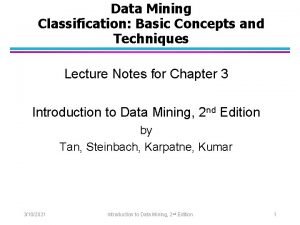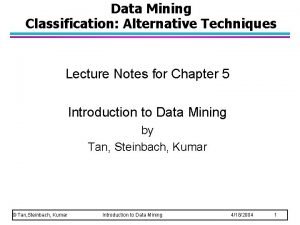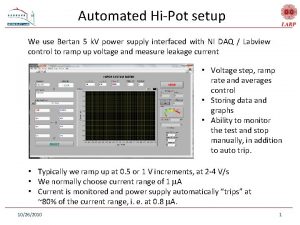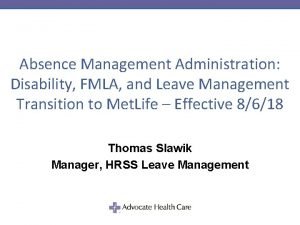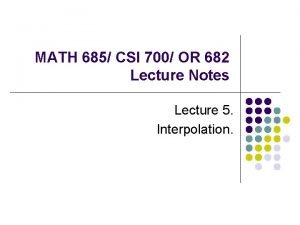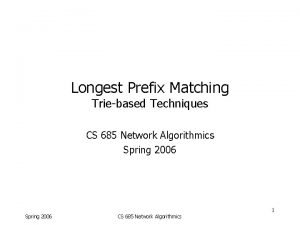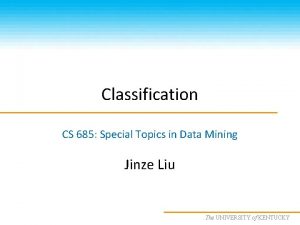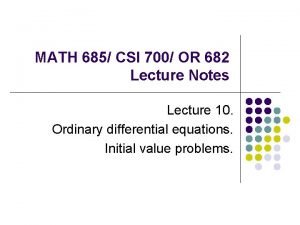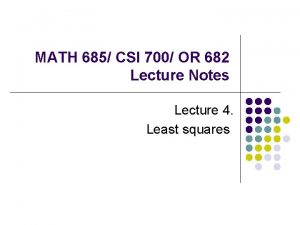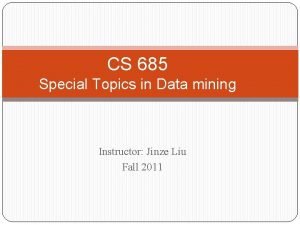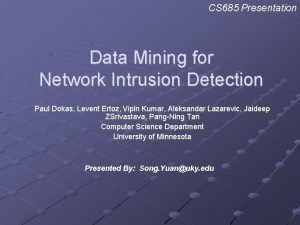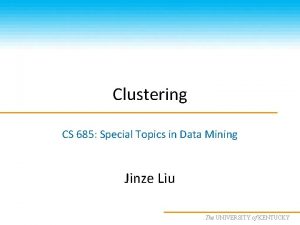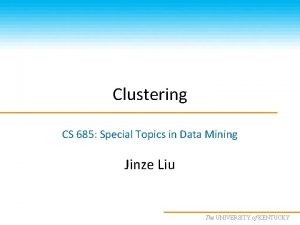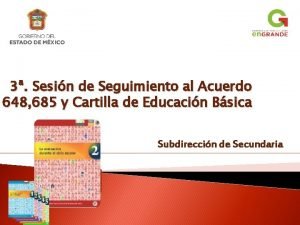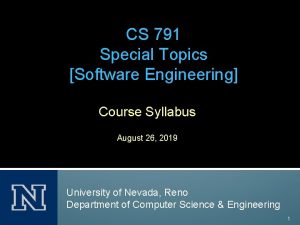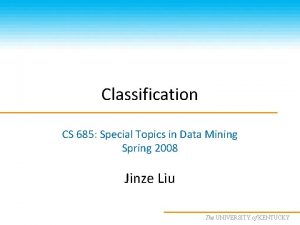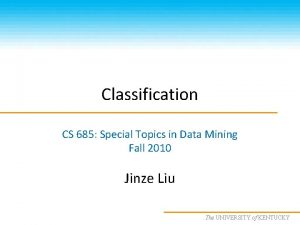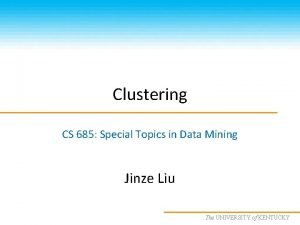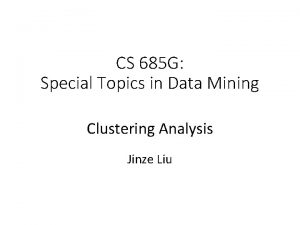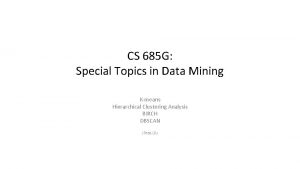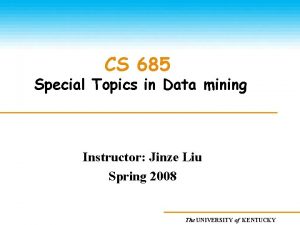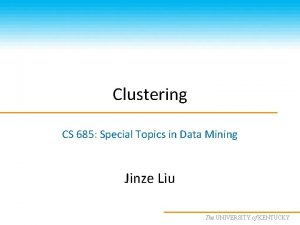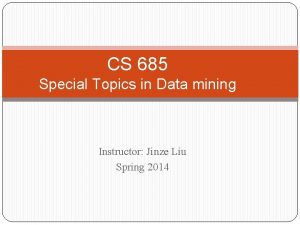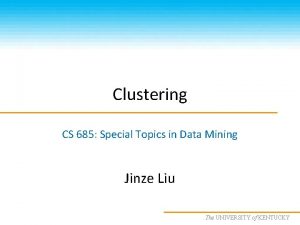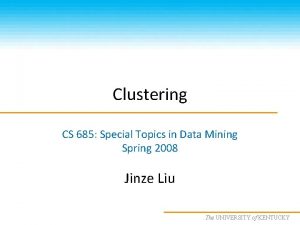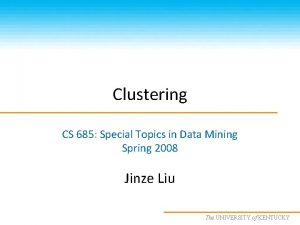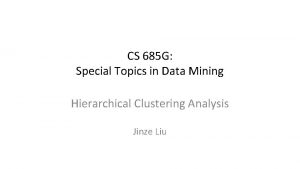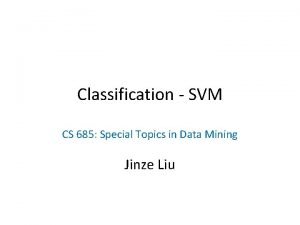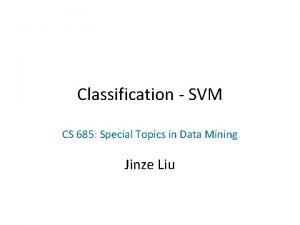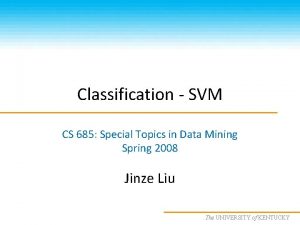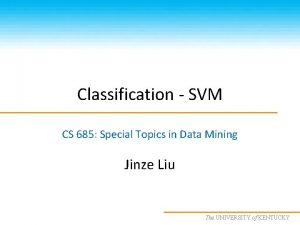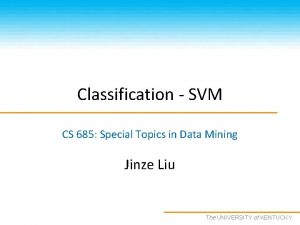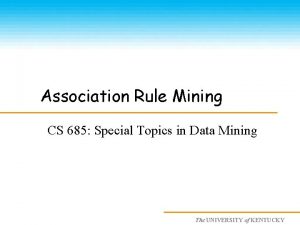Classification CS 685 Special Topics in Data Mining





























- Slides: 29

Classification CS 685: Special Topics in Data Mining Spring 2009 Jinze Liu The UNIVERSITY KENTUCKY CS 685 : Special Topics in Dataof Mining, UKY

Bayesian Classification: Why? • Probabilistic learning: Calculate explicit probabilities for hypothesis, among the most practical approaches to certain types of learning problems • Incremental: Each training example can incrementally increase/decrease the probability that a hypothesis is correct. Prior knowledge can be combined with observed data. • Probabilistic prediction: Predict multiple hypotheses, weighted by their probabilities • Standard: Even when Bayesian methods are computationally intractable, they can provide a standard of optimal decision making against which other methods can be measured CS 685 : Special Topics in Data Mining, UKY

Bayesian Theorem: Basics • Let X be a data sample whose class label is unknown • Let H be a hypothesis that X belongs to class C • For classification problems, determine P(H/X): the probability that the hypothesis holds given the observed data sample X • P(H): prior probability of hypothesis H (i. e. the initial probability before we observe any data, reflects the background knowledge) • P(X): probability that sample data is observed • P(X|H) : probability of observing the sample X, given that the hypothesis holds CS 685 : Special Topics in Data Mining, UKY

Bayesian Theorem • Given training data X, posteriori probability of a hypothesis H, P(H|X) follows the Bayes theorem • Informally, this can be written as posterior =likelihood x prior / evidence • MAP (maximum posteriori) hypothesis • Practical difficulty: require initial knowledge of many probabilities, significant computational cost CS 685 : Special Topics in Data Mining, UKY

Naïve Bayes Classifier • A simplified assumption: attributes are conditionally independent: • The product of occurrence of say 2 elements x 1 and x 2, given the current class is C, is the product of the probabilities of each element taken separately, given the same class P([y 1, y 2], C) = P(y 1, C) * P(y 2, C) • No dependence relation between attributes • Greatly reduces the computation cost, only count the class distribution. • Once the probability P(X|Ci) is known, assign X to the class with maximum P(X|Ci)*P(Ci) CS 685 : Special Topics in Data Mining, UKY

Training dataset Class: C 1: buys_computer= ‘yes’ C 2: buys_computer= ‘no’ Data sample X =(age<=30, Income=medium, Student=yes Credit_rating= Fair) CS 685 : Special Topics in Data Mining, UKY

Naïve Bayesian Classifier: Example • Compute P(X/Ci) for each class P(age=“<30” | buys_computer=“yes”) = 2/9=0. 222 P(age=“<30” | buys_computer=“no”) = 3/5 =0. 6 P(income=“medium” | buys_computer=“yes”)= 4/9 =0. 444 P(income=“medium” | buys_computer=“no”) = 2/5 = 0. 4 P(student=“yes” | buys_computer=“yes”)= 6/9 =0. 667 P(student=“yes” | buys_computer=“no”)= 1/5=0. 2 P(credit_rating=“fair” | buys_computer=“yes”)=6/9=0. 667 P(credit_rating=“fair” | buys_computer=“no”)=2/5=0. 4 X=(age<=30 , income =medium, student=yes, credit_rating=fair) P(X|Ci) : P(X|buys_computer=“yes”)= 0. 222 x 0. 444 x 0. 667 =0. 044 P(X|buys_computer=“no”)= 0. 6 x 0. 4 x 0. 2 x 0. 4 =0. 019 P(X|Ci)*P(Ci ) : P(X|buys_computer=“yes”) * P(buys_computer=“yes”)=0. 028 P(X|buys_computer=“no”) * P(buys_computer=“no”)=0. 007 X belongs to class “buys_computer=yes” CS 685 : Special Topics in Data Mining, UKY

Naïve Bayesian Classifier: Comments • Advantages : – Easy to implement – Good results obtained in most of the cases • Disadvantages – Assumption: class conditional independence , therefore loss of accuracy – Practically, dependencies exist among variables – E. g. , hospitals: patients: Profile: age, family history etc Symptoms: fever, cough etc. , Disease: lung cancer, diabetes etc – Dependencies among these cannot be modeled by Naïve Bayesian Classifier • How to deal with these dependencies? – Bayesian Belief Networks CS 685 : Special Topics in Data Mining, UKY

Bayesian Networks • Bayesian belief network allows a subset of the variables conditionally independent • A graphical model of causal relationships – Represents dependency among the variables – Gives a specification of joint probability distribution Y X Z P q. Nodes: random variables q. Links: dependency q. X, Y are the parents of Z, and Y is the parent of P q. No dependency between Z and P q. Has no loops or cycles CS 685 : Special Topics in Data Mining, UKY

Bayesian Belief Network: An Example Family History Smoker (FH, S) Lung. Cancer Positive. XRay Emphysema Dyspnea Bayesian Belief Networks (FH, ~S) (~FH, ~S) LC 0. 8 0. 5 0. 7 0. 1 ~LC 0. 2 0. 5 0. 3 0. 9 The conditional probability table for the variable Lung. Cancer: Shows the conditional probability for each possible combination of its parents CS 685 : Special Topics in Data Mining, UKY

Learning Bayesian Networks • Several cases – Given both the network structure and all variables observable: learn only the CPTs – Network structure known, some hidden variables: method of gradient descent, analogous to neural network learning – Network structure unknown, all variables observable: search through the model space to reconstruct graph topology – Unknown structure, all hidden variables: no good algorithms known for this purpose • D. Heckerman, Bayesian networks for data mining CS 685 : Special Topics in Data Mining, UKY

Association Rules Transactionid Items bought 100 f, a, c, d, g, I, m, p 200 a, b, c, f, l, m, o 300 b, f, h, j, o 400 b, c, k, s, p 500 a, f, c, e, l, p, m, n Customer buys both Customer buys beer Customer buys diaper Itemset X = {x 1, …, xk} Find all the rules X Y with minimum support and confidence support, s, is the probability that a transaction contains X Y confidence, c, is the conditional probability that a transaction having X also contains Y Let supmin = 50%, confmin = 50% Association rules: A C (60%, 100%) C A (60%, 75%) CS 685 : Special Topics in Data Mining, UKY

Classification based on Association • Classification rule mining versus Association rule mining • Aim – A small set of rules as classifier – All rules according to minsup and minconf • Syntax – X y – X Y CS 685 : Special Topics in Data Mining, UKY

Why & How to Integrate • Both classification rule mining and association rule mining are indispensable to practical applications. • The integration is done by focusing on a special subset of association rules whose right-hand-side are restricted to the classification class attribute. – CARs: class association rules CS 685 : Special Topics in Data Mining, UKY

CBA: Three Steps • Discretize continuous attributes, if any • Generate all class association rules (CARs) • Build a classifier based on the generated CARs. CS 685 : Special Topics in Data Mining, UKY

Our Objectives • To generate the complete set of CARs that satisfy the user-specified minimum support (minsup) and minimum confidence (minconf) constraints. • To build a classifier from the CARs. CS 685 : Special Topics in Data Mining, UKY

Rule Generator: Basic Concepts • Ruleitem <condset, y> : condset is a set of items, y is a class label Each ruleitem represents a rule: condset->y • condsup. Count • The number of cases in D that contain condset • rulesup. Count • The number of cases in D that contain the condset and are labeled with class y • Support=(rulesup. Count/|D|)*100% • Confidence=(rulesup. Count/condsup. Count)*100% CS 685 : Special Topics in Data Mining, UKY

RG: Basic Concepts (Cont. ) • Frequent ruleitems – A ruleitem is frequent if its support is above minsup • Accurate rule – A rule is accurate if its confidence is above minconf • Possible rule – For all ruleitems that have the same condset, the ruleitem with the highest confidence is the possible rule of this set of ruleitems. • The set of class association rules (CARs) consists of all the possible rules (PRs) that are both frequent and accurate. CS 685 : Special Topics in Data Mining, UKY

RG: An Example • A ruleitem: <{(A, 1), (B, 1)}, (class, 1)> – assume that • the support count of the condset (condsup. Count) is 3, • the support of this ruleitem (rulesup. Count) is 2, and • |D|=10 – then (A, 1), (B, 1) -> (class, 1) • supt=20% (rulesup. Count/|D|)*100% • confd=66. 7% (rulesup. Count/condsup. Count)*100% CS 685 : Special Topics in Data Mining, UKY

RG: The Algorithm 1 F 1 = {large 1 -ruleitems}; 2 CAR 1 = gen. Rules (F 1 ); 3 pr. CAR 1 = prune. Rules (CAR 1 ); //count the item and class occurrences to determine the frequent 1 -ruleitems and prune it 4 for (k = 2; F k-1 Ø; k++) do 5 C k = candidate. Gen (F k-1 ); //generate the candidate ruleitems Ck 6 7 using the frequent ruleitems Fk-1 for each data case d D do //scan the database C d = rule. Subset (C k , d); //find all the ruleitems in Ck whose condsets are supported by d 8 9 10 11 12 for each candidate c C d do c. condsup. Count++; if d. class = c. class then c. rulesup. Count++; //update various support counts of the candidates in Ck end CS 685 : Special Topics in Data Mining, UKY

RG: The Algorithm(cont. ) 13 F k = {c C k | c. rulesup. Count minsup}; //select those new frequent ruleitems to form Fk 14 CAR k = gen. Rules(F k ); //select the ruleitems both accurate and frequent 15 pr. CAR k = prune. Rules(CAR k ); 16 end 17 CARs = k CAR k ; 18 pr. CARs = k pr. CAR k ; CS 685 : Special Topics in Data Mining, UKY

SVM – Support Vector Machines Small Margin Large Margin Support Vectors CS 685 : Special Topics in Data Mining, UKY

SVM – Cont. • Linear Support Vector Machine Given a set of points with label The SVM finds a hyperplane defined by the pair (w, b) (where w is the normal to the plane and b is the distance from the origin) s. t. x – feature vector, b- bias, y- class label, 2/||w|| - margin CS 685 : Special Topics in Data Mining, UKY

SVM – Cont. CS 685 : Special Topics in Data Mining, UKY

SVM – Cont. • What if the data is not linearly separable? • Project the data to high dimensional space where it is linearly separable and then we can use linear SVM – (Using Kernels) (0, 1) + + -1 0 +1 (0, 0) + (1, 0) CS 685 : Special Topics in Data Mining, UKY

Non-Linear SVM Classification using SVM (w, b) In non linear case we can see this as Kernel – Can be thought of as doing dot product in some high dimensional space CS 685 : Special Topics in Data Mining, UKY

Example of Non-linear SVM CS 685 : Special Topics in Data Mining, UKY

Results CS 685 : Special Topics in Data Mining, UKY

SVM Related Links • http: //svm. dcs. rhbnc. ac. uk/ • http: //www. kernel-machines. org/ • C. J. C. Burges. A Tutorial on Support Vector Machines for Pattern Recognition. Knowledge Discovery and Data Mining, 2(2), 1998. • SVMlight – Software (in C) http: //ais. gmd. de/~thorsten/svm_light • BOOK: An Introduction to Support Vector Machines N. Cristianini and J. Shawe-Taylor Cambridge University Press CS 685 : Special Topics in Data Mining, UKY
 Eck
Eck Mining multimedia databases
Mining multimedia databases Bayesian classification in data mining lecture notes
Bayesian classification in data mining lecture notes Classification and clustering in data mining
Classification and clustering in data mining Basic concepts of classification in data mining
Basic concepts of classification in data mining Classification alternative techniques in data mining
Classification alternative techniques in data mining Strip mining vs open pit mining
Strip mining vs open pit mining Strip mining before and after
Strip mining before and after Difference between strip mining and open pit mining
Difference between strip mining and open pit mining Web text mining
Web text mining 1000-685
1000-685 8476851447
8476851447 Mth 685
Mth 685 Cs 685
Cs 685 Cs 685
Cs 685 Cs 685
Cs 685 Mth 685
Mth 685 Mth 685
Mth 685 Cs 685
Cs 685 Cs 685
Cs 685 Cs 685
Cs 685 Cs 685
Cs 685 Cs 685
Cs 685 Acuerdo 685
Acuerdo 685 Special investigative topics 3232 answers
Special investigative topics 3232 answers Dena schlosser
Dena schlosser Software engineering course syllabus
Software engineering course syllabus Data reduction in data mining
Data reduction in data mining What is data mining and data warehousing
What is data mining and data warehousing What is missing data in data mining
What is missing data in data mining




